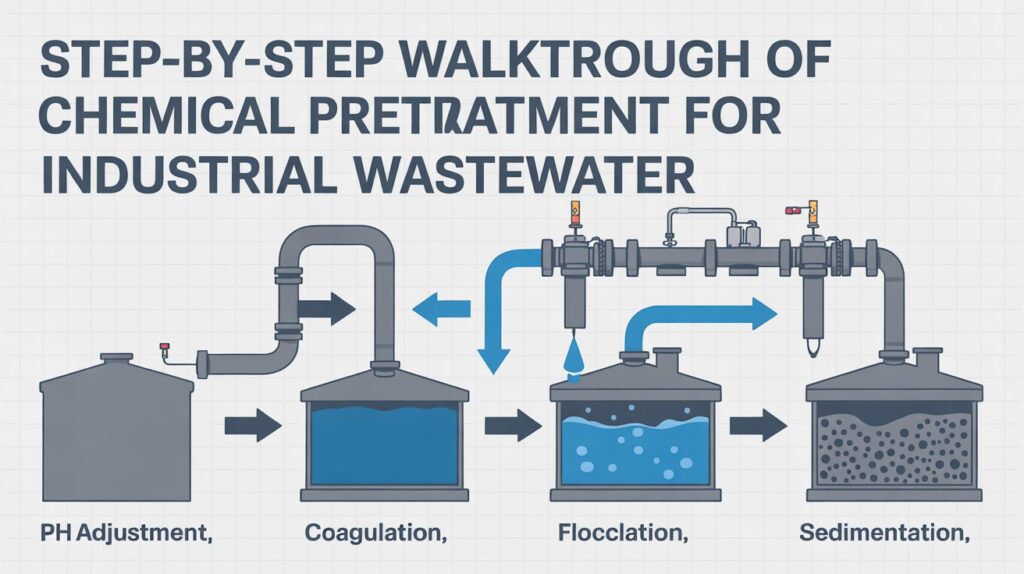Industrial wastewater contains a mix of suspended solids, metals, oils, and other pollutants that must be treated before safe discharge. Chemical pretreatment plays a crucial role in removing these impurities and protecting downstream systems. Each stage contributes to efficient treatment and compliance with environmental regulations.
1. Initial Assessment and Screening
The first step in any chemical pretreatment process is assessing the nature of the wastewater. Facilities conduct sampling to determine pH, turbidity, and the concentration of dissolved contaminants. For more technical insight into water treatment solutions, visit this website to explore practical approaches used by leading providers. This initial data guides the selection of the right chemicals and system setup.
Screening follows assessment to remove large solids that could hinder chemical reactions later. Grates, filters, or mesh screens capture debris such as plastics, fibres, or sediment. Removing these particles ensures chemical agents act effectively on dissolved or colloidal pollutants. It also helps prevent wear and tear on downstream treatment units.
2. pH Adjustment and Neutralisation
Before coagulants or flocculants are added, the wastewater’s pH must be adjusted to an optimal range. Most chemical reactions in treatment systems work best between slightly acidic and neutral pH levels. Acids or alkalis such as sulphuric acid and lime are dosed carefully to achieve this balance. Proper pH control enhances the efficiency of subsequent processes and stabilises the overall system.
Inconsistent pH levels can disrupt coagulant reactions or damage treatment infrastructure. Automated control systems are often installed to measure pH in real time and adjust dosing rates. Maintaining proper pH also prevents corrosion and ensures the safety of storage tanks and pipes.
3. Coagulation and Floc Formation
Coagulation involves adding positively charged chemicals, such as aluminium sulphate or ferric chloride, that neutralise the negative charges on suspended particles. Once neutralised, these particles begin clumping together to form microflocs. Proper mixing ensures even distribution of chemicals and promotes effective contact between the particles. This step prepares the wastewater for flocculation and settling.
Common Coagulants and Their Uses
- Aluminium-based salts for general solid removal
- Iron-based salts for stronger bonding in high-strength waste streams
- Organic polymers to enhance floc density and settleability
Floc formation follows coagulation, where gentle agitation encourages microflocs to join into larger, more visible clusters. These flocs are easier to remove through sedimentation or flotation. The effectiveness of this stage depends on temperature, chemical concentration, and mixing intensity.
4. Sedimentation and Sludge Removal
After flocs form, wastewater flows into a sedimentation tank where gravity helps solids settle at the bottom. Clear water rises to the top while the heavier sludge collects below. This sludge is then directed to separate handling units or dewatering systems for further treatment. Regular desludging helps maintain capacity and avoids build-up that could affect water flow.
Lamella clarifiers or inclined plate settlers are sometimes used to improve space efficiency. These systems shorten the settling path, allowing higher flow rates without compromising clarity. Consistent sludge removal ensures stable plant operation and compliance with discharge limits.
5. Oxidation and Final Polishing
Oxidation targets residual organic matter, odours, and colour. Chemicals such as hydrogen peroxide, chlorine, or ozone break down complex molecules into simpler, less harmful compounds. The result is a clearer and more stable effluent ready for biological or tertiary treatment.
In some facilities, activated carbon or sand filtration follows oxidation for added polishing. These filters capture remaining fine particles or traces of chemical residue. Monitoring instruments track parameters like chemical oxygen demand (COD) to confirm treatment success. Together, oxidation and filtration complete the pretreatment phase and prepare the water for safe discharge or reuse.
Chemical pretreatment provides a structured and reliable path to make industrial wastewater safer for further treatment. Each stage, from assessment to oxidation, contributes to stable operation and improved compliance. Facilities that follow these systematic steps achieve better results and fewer disruptions.

